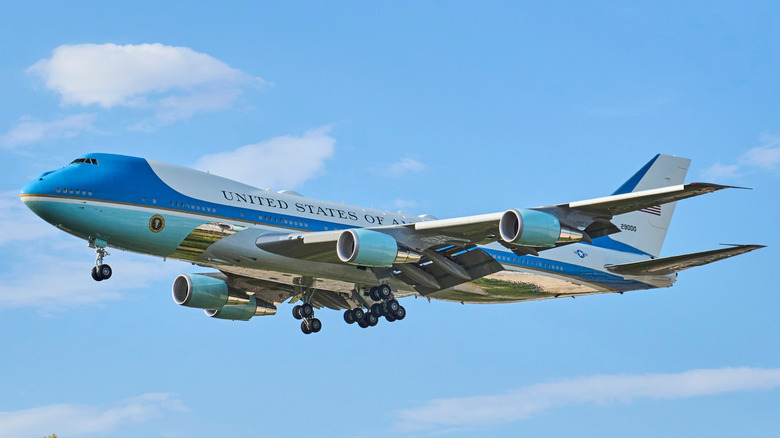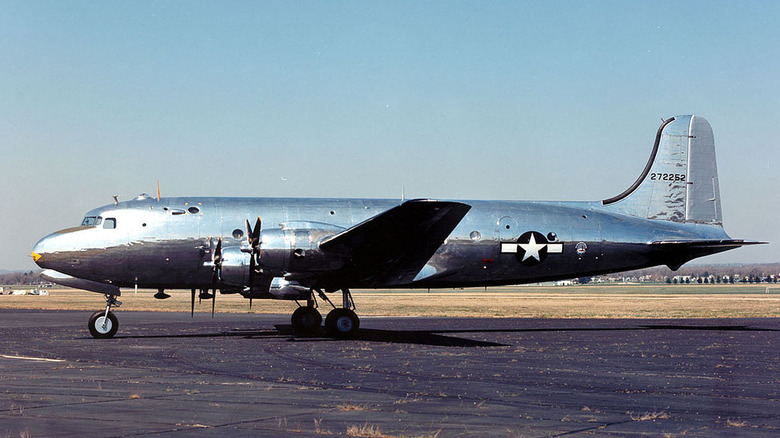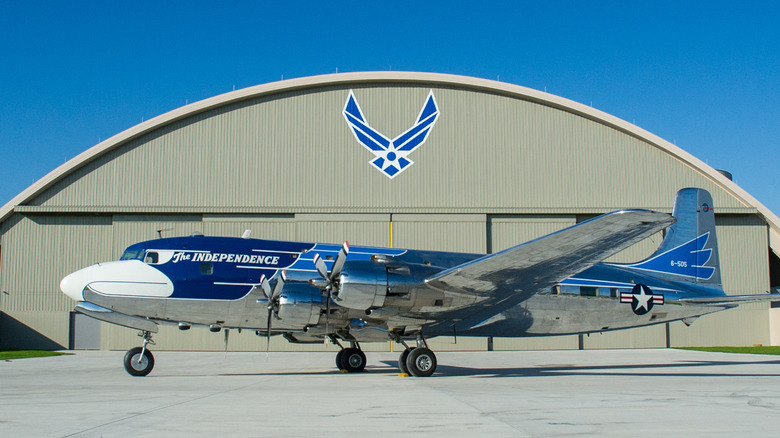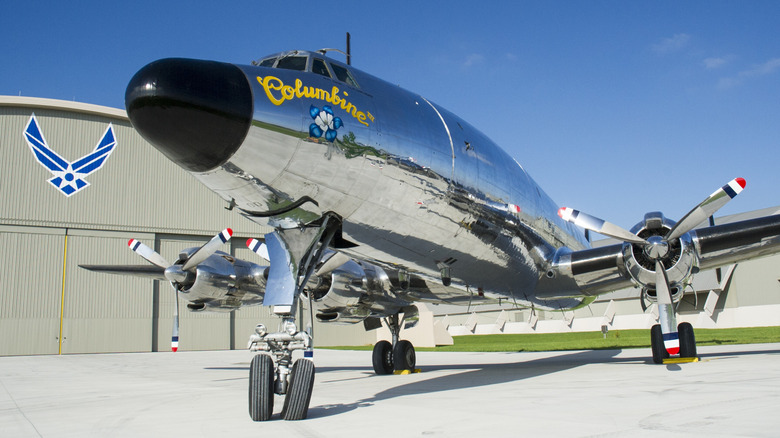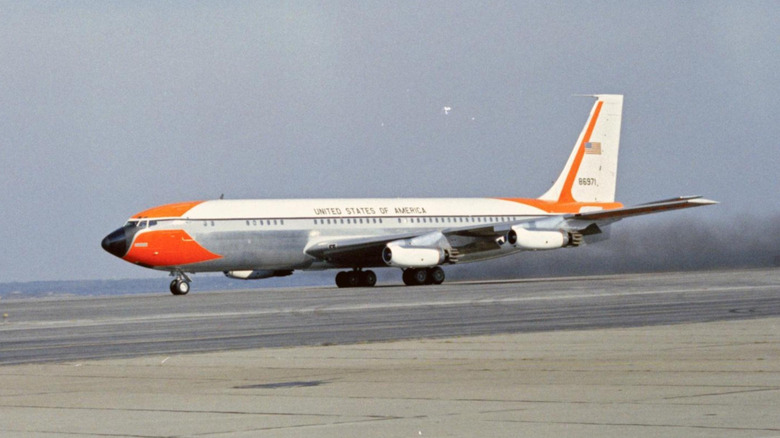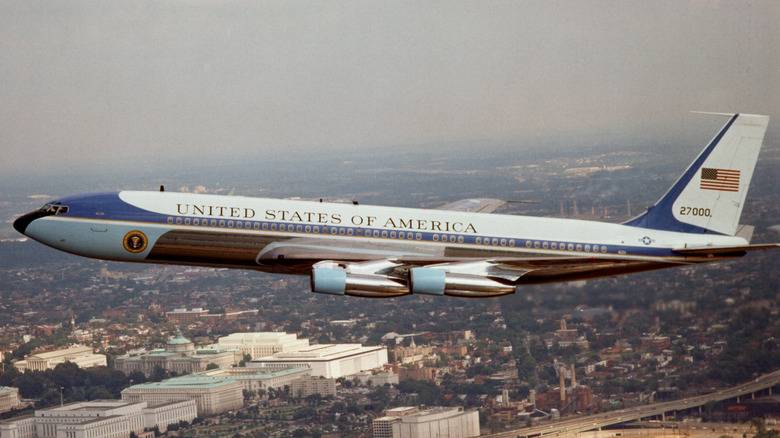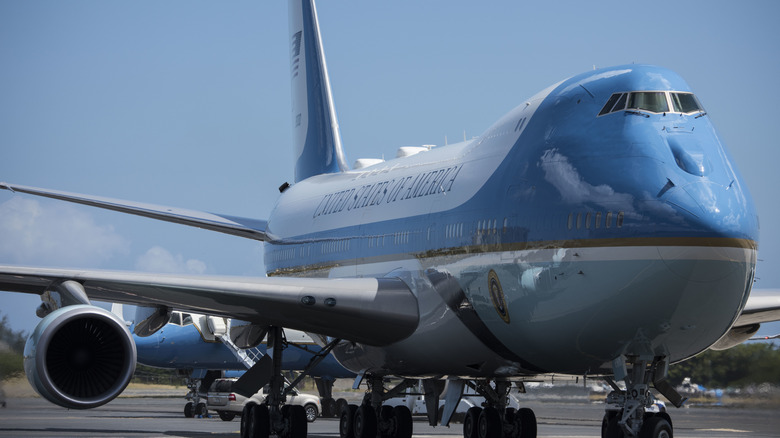Air Force One Paint Schemes: Presidential Plane Livery Over The Years
With its imposing profile and recognizable blue and white color, the aircraft known as Air Force One is among the most famous planes in the world. Throughout its history, there have been many different kinds of airplanes to use the name, but all of them have had the same purpose — to act as a mobile command center and secure transport for the president of the United States.
The modern Air Force One aircraft are actually two very sophisticated and highly modified Boeing 747-200B airplanes. Because of its role, it is equipped with many advanced features, including fortified security, communications, and defense systems. As an airborne White House, it has its own presidential suite, office, medical, and sleeping quarters, allowing the president to continue in his duties despite being airborne.
From its inception, the aircraft that would transport the government's highest official has been a series of specially re-engineered and upgraded airplane. Throughout the years, the designs for each have varied, oftentimes reflecting the time period they were in service for.
The first presidential airplane
It was in 1944, during the closing months of World War II, that a Douglas VC-54C was adopted for use by President Franklin D. Roosevelt as the first American president to use aircraft transport. Originally called "The Flying White House," the airplane soon operated under another moniker called "The Sacred Cow," due to its status as a presidential transport aircraft, and its ensuing demand for higher security and secrecy.
His successor, President Harry S. Truman, continued to use this airplane during his term. This "Flying White House" is considered an important part of United States Air Force history, when on July 26, 1947, the National Security Act of 1947 was signed mid-flight on the Sacred Cow.
Notable features of the airplane included a built-in elevator, bulletproof glass windows, and a modest appearance with just the exposed aluminum panels and no paint. The U.S. Air Force roundel was its sole marking, emblazoned on the side at the rear of the plane.
The Independence
By the end of 1947, a newer aircraft was put into service for use by President Harry S. Truman. This custom Douglas VC-118 was called the "Independence" — at the suggestion of President Truman himself in recognition of his hometown of Independence, Missouri — and was used extensively until the end of his term in 1953.
For greater range, this aircraft had improved engines and larger fuel tanks, alongside more modern equipment including features like autopilot, weather radar, and an altimeter system. Visually, the VC-118 had a brighter color scheme than its predecessor: Featuring a white and blue American Eagle, with feathers painted from the nose cone that extended throughout the fuselage, and down to the vertical stabilizer.
After being flown for six years for White House service, the Independence was later used by the U.S. Air Forces for VIP transport duties until its retirement, and became part of a museum display in 1965.
The inaugural callsign Air Force One
When President Dwight D. Eisenhower came into office, a different aircraft was acquired for his use, now supplied by Lockheed. The VC-121A-LO, or "Columbine II," was the second Lockheed Constellation that President Eisenhower used — having previously assigned an earlier Constellation also named "Columbine" when he was a high-ranking general.
The Columbine II was named after the state flower of Colorado, in honor of the home state of Mrs. Eisenhower. This was then replaced by another Constellation named Columbine III, a larger and more powerful airplane. Like its forerunner, Columbine III was unpainted, featured the U.S. Air Force roundel, and had a Columbine flower painted near the nose cone of the aircraft.
The callsign "Air Force One" was first used for this aircraft because of a near accident in 1953, when Air Force flight 8610 — the plane carrying President Eisenhower — and Eastern Airlines flight 8610 nearly collided. This caused confusion for air traffic control and flight crews because of the same number not differentiating enough between them.
To avoid future incidents, it was decided that any Air Force plane carrying the President will have the designation Air Force One, which was initially used informally until 1962, when this designation became official.
Jet-age Air Force One
After getting re-elected for his second term, President Eisenhower was the first U.S. President to use the next-generation, jet-powered aircraft. The new VC-137A from Boeing was a 707 Stratoliner named "Queenie," which was a much more advanced and powerful airplane. This Boeing could accommodate more passengers, and had special conference, communications, and stateroom areas.
The Stratoliner had a unique paint scheme not seen again in modern Air Force One jets, wherein it had a black nose, red front and rear livery, and its fuselage was a two-toned white and silver. This unique paint scheme was a carryover of the U.S. Air Force International Orange color of its aircraft. This was later changed when John F. Kennedy became president, switching to the familiar coloring of Air Force One seen today.
Because of its more powerful engines and longer range, the Queenie was used for much international travel, including a ground-breaking three-week goodwill journey by then-President Eisenhower that covered 11 countries across three continents in 1959.
Bigger and bolder Air Force One jets
Entering service for use by President John F. Kennedy in 1962, the SAM 26000 — which meant Special Air Mission — was a Boeing 707 VC-137C that was specifically created and customized for use by a United States President. This was the first aircraft to officially use the callsign Air Force One from inception.
The VC-137C is notable as the first aircraft to be adorned with the Raymond Loewy design and Presidential logo, which are still being used today. Important milestones for this aircraft were that it was used to ferry President Kennedy after his assassination, and is where his Vice-President Lyndon Johnson took his oath to assume the presidency.
President Johnson continued the use of SAM 26000 until 1969, and in 1972, another VC-137C with tail number SAM 27000 was later added to the fleet for use by President Richard Nixon. Many modifications were added by President Nixon to the SAM 26000 to fit his preferences, including changing its interior layout and adding the name "The Spirit of '76" on its nose cone.
Tough and dependable upgrade
As the second Boeing 707 series used as presidential aircraft, the SAM 27000 initially was the backup plane until it took the primary transport duties in 1972, during the latter years of the Nixon administration. The SAM 2700 was a workhorse, having served seven U.S. heads of state; starting from President Richard M. Nixon up to President George W. Bush. During the time of President Ronald Reagan, the SAM 27000 was well-utilized, and the airplane accumulated 675,000 miles for his numerous state visits to various countries.
Because of its role as Air Force One, numerous contemporary technological innovations were installed on the SAM 27000, which included updated avionics, defense, and mechanical systems to further improve its capabilities and performance. The SAM 27000 was relegated to backup aircraft status when the new VC-25 was put in service, and was finally retired in 2001. Today, the airplane is now housed as a display in the Reagan Library in Simi Valley, California.
Today's Air Force One presidential plane
By 1986, plans to replace the VC-137 were made, and two manufacturers — Boeing and Lockheed — submitted their proposals. Boeing was selected to replace with a new plane, and the resulting 747 200-B-based VC-25A is bigger, has a longer range, and has more space for working areas, cargo storage, and passenger seating.
Important upgrades for this edition of Air Force One include aerial refueling capability, defensive counter-measures against attack including radar jamming, hardened electronics, and flare and chaff for use against missiles.
Now on its 38th year of service, the VC-25A is the longest-serving Air Force One aircraft to date and currently serves President Donald Trump as his airborne White House. The United States Air Force has already announced that it has selected Boeing as the supplier for the new Air Force One, which is a Boeing 747-8S, and will be named VC-25. The new generation Air Force One is scheduled to make its debut by 2027.
